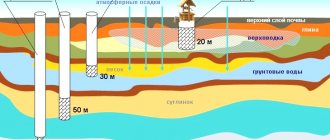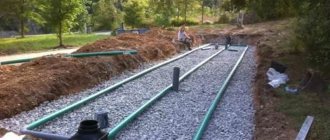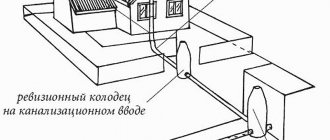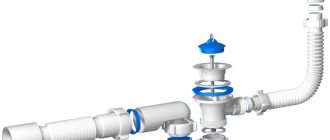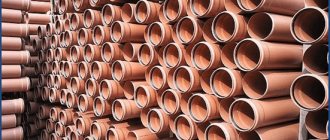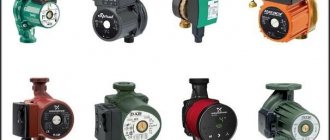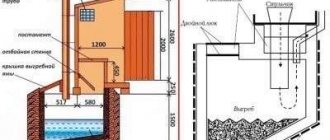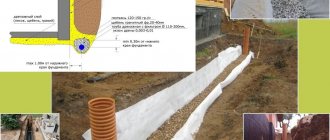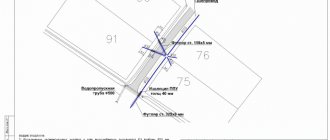Sewage systems in a private home can have different designs; there are industrial designs that are characterized by high performance and environmental friendliness. Dirty water enters containers and goes through several stages of purification. At the exit, all the dirt is gone and clean water remains, which can be poured into the ground or reservoirs.
But such systems require constant attention - you need to promptly change the reagents used for cleaning. And the choice of septic tanks should be approached thoroughly - the convenience of the people living in the house will depend on its operation.
Sewerage for a country house what to choose
Installation of the sewer system should be carried out only after preparatory work. The most important thing is to determine the amount you are willing to spend on the project. Sewerage in a private house, options for which need to be considered at the cottage design stage, must be developed taking into account all the requirements:
- The number of people living in the house.
- There is such a thing as a salvo discharge - the flow of wastewater into the sewer. This is a short-term phenomenon, but it must be taken into account. It determines the peak load on the entire sewer system. If a large number of plumbing fixtures are involved in the house, then you need to consider that they can sometimes work simultaneously. The autonomous sewer design you choose for a private house must have several chambers, and to avoid overflow, you need to make the correct calculation.
- The performance of a cleaning system is throughput. For industrial designs of sewer systems, this parameter is indicated in the technical passport. The unit of measurement is cubic meters or the number of liters per day. The sewerage capacity must correspond to the volume of wastewater that is discharged from a private home.
- The depth at which the sewer pipe is located must be sufficient so that the water does not freeze at subzero temperatures.
- Regardless of what type of water supply is used, only high-performance sewer systems are chosen for a private home. Whatever design of autonomous systems you choose, you need to provide it with a constant power supply. Most cleaning systems are equipped with special electronic control units, alarms, aerators, compressors and pumps. These nodes allow you to completely get rid of human intervention in the functioning of the system.
- The treatment facility can be made of various materials. The most commonly used materials are fiberglass, polyethylene, polypropylene, metal and concrete. Both installation features and maintenance nuances depend on the material.
- Be sure to take into account the properties of the terrain - whether there are slopes, ponds, drainage wells, water use points.
- The type and structure of the soil also needs to be taken into account when designing a sewer system. The cost of installation and its complexity depend on the type of soil on the site.
- Groundwater - sewerage must be located above the depth of its occurrence.
- The area of land that you can allocate for the construction of a structure.
The simplest and cheapest solution is a cesspool. But it has many disadvantages, so summer residents are trying to abandon this method. It is advisable to use progressive systems in a private home, these include a septic tank - this is a completely sealed container that contains one or more chambers. Wastewater enters them, goes through one or more stages of purification, after which it can be pumped out using a pump.
Types of VOCs
The installation of a local structure for the treatment of domestic wastewater is preceded by the calculation of the structure’s parameters. During this process, it is taken into account that 1 person can cause the appearance of from 160 to 200 liters of sewage in 24 hours.
It is important to use these numbers when calculating the volume of VOCs. After all, in a tank with insufficient capacity, wastewater will not have time to settle. This will result in dirty liquid being discharged onto the soil.
It turns out that the VOC sewerage system is a structure, the volume of which must be no less than the calculated value. Huge containers should also not be installed, since you will have to spend an unreasonably large amount of money.
The volume of VOCs is selected for the specific number of people in the house Source s8.hostingkartinok.com
Types of sewerage
There are different types of sewers for a private home; two large groups can be distinguished:
- Gravity - the design has many advantages, since it does not require pumps or a nearby electrical network. During operation there is no need to spend extra money on maintenance. The system is convenient to operate - all wastewater flows through the pipes under the influence of its own weight due to a slight slope. The main thing in the calculations is to correctly determine the magnitude of the slope. It is advisable to make a slope of 3 cm per linear meter of pipe.
- Water moves at a faster speed than the solid particles it contains. Therefore, if you make the slope larger, the water will drain, and solid particles will remain in the pipe. As a result, blockages will appear that need to be cleared. The disadvantage of such a system is that it will not be able to function at a great distance from home. If you decide to use this type of sewer in a private house, you must choose the correct slope value. And most importantly, you can’t make turns.
- Pressure type sewer systems are considered the best option if the distance from the septic tank to the house is large. The principle of operation is that the pump creates pressure, and all waste tends to exit along with water. If pumps are used, it is allowed to turn the pipes; they will not have any effect. Among the disadvantages, one can highlight the fact that electricity is constantly consumed, and if the power goes out, it will not be possible to use the sewerage system.
Before installing and installing a sewerage system, you need to decide which type you need to use in your case. Based on the drainage method, the following systems can be distinguished:
- All-alloy - they combine all the drains. These are atmospheric, household and industrial waste.
- In a semi-separate system, industrial and domestic waste are sent to the sewer system, and atmospheric waste is first collected in ducts and ditches.
- The separate type is characterized by the fact that it has two channels. One receives atmospheric water, the other receives household waste. Thanks to this, the cleaning system is not overloaded.
External sewage system
Using an external sewage system in a private home, waste is collected and transported to the discharge point into a cleaning tank. The system includes not only pipelines, but also the following elements:
- Septic tanks.
- Inspection wells for monitoring the condition of the treatment system.
- Local treatment facilities.
General installation rules
It is necessary to locate the septic tank no closer than five meters from the house. The water source must be at least twenty meters from the drains . A residential building can be located at a distance of more than eight meters from filtration wells and twenty-five meters from filtration fields.
A distance of at least fifty meters is allowed to aeration purifiers, and from three hundred meters to drain stations.
To prevent pipes from being damaged in winter, it is necessary to insulate them, for example, with mineral wool. Also, all sewer pipes must be installed at the correct angle. External pipes must be at least one hundred millimeters in diameter.
Types of recyclers
Depending on the sewer system, you will use different types of cleaning systems and secondary elements. If you are planning to build a sewerage system that can last for several decades, be prepared to invest a large amount of money in it.
Storage sewer
Cumulative sewer systems are designed to store waste water. You can make an individual system (sewage), but how to choose a pump for sewerage depends on the installation conditions. A pump is necessary if the distance to the storage tank is large. A storage sewer is an improved cesspool, but it has a peculiarity - waste does not go into the soil. Design:
- Determine the location where it is best to install the sewer container.
- Calculate the volume required for the normal functioning of the sewer system. The main thing is to keep the sewer tank filled as long as possible.
- Select installation method. In most cases, the container is buried in the ground.
- Establish a schedule for dust inspection and cleanup.
Among the disadvantages of sewerage, one can highlight the need for cleaning and a platform to ensure access for cars. If it is not possible to organize access for a sewer truck to the sewer, you need to install pumps for pumping. The advantages include:
- Low cost.
- Environmentally friendly, since all waste is drained into a sealed tank.
- Simple installation and sewer connection.
- There is no need to install special equipment for maintenance.
Septic tanks
The peculiarity of a septic tank is that it purifies all wastewater. There are three types of this type of sewer:
- Sewers with post-treatment using soil - they have several chambers, and the latter does not have a closed surface.
- Cumulative sewer systems are completely sealed containers that are connected to the drainage system.
- If sanitary standards do not allow the release of poorly treated water into the soil, sealed sewers are used.
When operating a sewer septic tank, there is no need to clean the tank. The structure consists of the following elements:
- Several containers connected using pipes.
- Sealed lids on all containers.
- Ventilation holes.
- Connecting pipes.
Local treatment stations
The advantage of this type of sewage system is its high productivity and degree of purification. But the cost of such sewerage systems is high, so they are rarely used for installation in private homes. The sewer system is a septic tank, but wastewater treatment is much more efficient. Suspended particles are crushed, decomposed by bacteria, and water is formed at the outlet.
Biological treatment
This type of cleaning is perfect for both dachas and cottage communities. It involves the use of sludge with a high content of microorganisms that process all organic substances, that is, household waste, through oxidation.
The system operates on the principle of forced oxygen injection, as a result of which aerobic bacteria multiply and enter the device with waste.
Bacteria oxidize sewage, clearing it of odor and all dirt. The final product resembles flakes and is a clear sludge that does not rot.
Filter fields
Filtration fields are an area of land consisting of trenches in which spray pipes pass. Their work is based on the fact that the soil can be cleaned naturally.
You can build filtering fields yourself and this will save you a little money. However, you will have to call special equipment and purchase material.
Bioponds
Bioponds are a system of reservoirs or one pond, about a meter deep, in which the oxidation of organic substances occurs . Such ponds require measures to remove bottom silt, and in winter the oxygen regime of their operation should be monitored.
cesspool
The easiest way to dig a cesspool without a bottom with your own hands is a popular system option due to its low cost. This design is not suitable, however, for draining fecal matter, since it only processes the liquid part of the waste.
Septic tank
The principle of operation is that all wastewater from the sewer pipe flows into the first chamber, its bottom is concreted. Heavy particles settle to the bottom and are gradually processed by special anaerobic bacteria. All solid waste decomposes, releasing gases that escape through the vents. When designing, it is important to consider the size of the vent.
When the first chamber is filled, water flows into the second. If this is the last container, there is no need to make a hard bottom in it. If other containers are installed, the bottom should be concrete. In the last chamber, a cushion of crushed stone and sand is installed at the bottom; thanks to these components, water quickly goes into the soil.
Septic tank with biofilter
With the help of anaerobic bacteria, all organic waste is processed. As a result, the septic tank does not need to be pumped out for 10-20 years, and there is no need for regular cleaning. But this is provided that the volume is selected correctly. One person uses 200 liters of water per day. The volume of one container should be 9 m³ for a family of 4 people. This is enough for the normal functioning of the system.
Two-chamber septic tank
This design is reliable and low cost. It consists of two chambers, the first one removes large particles. They settle to the bottom under their own weight. Moreover, the bottom is concreted (if plastic containers are not used). You can make a septic tank from plastic containers of a suitable size. But it’s cheaper to purchase several reinforced concrete rings and make wells.
Video description
Features of installing a biological treatment station in wetlands are the topic of the following video:
The most common mistake when installing septic tanks is failure to follow the rules for backfilling. It is done sequentially: fill 1/3 with sand, fill 1/3 with water, etc.
- Firstly, this is necessary for the final shrinkage of the structure under its own weight.
- And secondly, if you leave the container empty and do not fill it with water, at high groundwater levels it may float
Failure to comply with this requirement often leads to depressurization of pipe connections and inlet pipes.
The drain pipe from the house is laid in a trench, the bottom of which is covered with sand. Before equipping the entrance to the septic tank, check its slope, which should be 2-3 degrees. Changing it in any direction changes the flow rate of the wastewater, which is why solid inclusions can linger in the pipe and form blockages.
It is very important to maintain the slope of the sewer line Source aquaterem.com
Pipes are also first backfilled with sand to prevent soil pressure on them, which increases in volume as it freezes.
Ready-made models and their features
Topas
High-quality sewer septic tanks are widely used in the construction of sewer systems for private homes and businesses. After the name there is a digital designation (for example, “Topas-4”, “Topas-60”). From it you can judge how many people the system is designed for (4 or 60). To install sewer systems in private homes, systems with an index from 4 to 20 are used. There are three more modifications:
- “Standard” - used in cases where the pipe lies at a depth of up to 0.8 m.
- “Long” - when used at a depth of 0.8 to 1.4 m. Feature: elongated neck.
- “Long Us” - such septic tanks are used at a pipe depth of 1.4 to 2.4 meters.
Tank
A sewer septic tank of this model looks like a large plastic cube. Its surfaces are ribbed (for reinforcement). There are one or two necks in the upper part; they protrude above the surface of the ground after installation is completed. This cube is divided inside into three equal compartments, in which the drain is cleaned.
There are no seams on the body; it is solid. There are seams only in the place where the neck is attached to the cube, but it is welded and is not much different from a monolithic one. The walls are 1 cm thick, and the ribs are 1.7 cm thick, increasing the strength of the structure. When installation takes place, there is no need to install a slab under the container as an anchor.
Tver
The Tver septic tank combines all the technologies used to process wastewater. In the first compartment, wastewater is mechanically treated (as in most septic tanks). In the second and third, water is processed by anaerobic bacteria and aeration occurs. A biofilter is connected to the outlet of the septic tank. According to the manufacturers, 98% purification occurs.
Eurobion
The peculiarity of this type of septic tank is that in the first compartment not only mechanical cleaning and grinding of suspended particles is carried out, but also aeration. Therefore, the operating efficiency of this type of structure is higher than that of its competitors.
Overflow tanks with filtration structures
When the groundwater lies deep, an overflow septic tank (a container divided into compartments) can be installed for the dacha.
Important! Such devices are suitable only for areas with low groundwater and for non-permanent residence.
Principle of operation
The first two sections of the septic tank are needed in order to stratify the primary wastewater into fractions:
- the lightest fractions float to the surface;
- fractions that are heavier than water settle to the bottom of the container and are then removed when the septic tank is pumped out with a sewer machine);
- everything else is poured into the next chamber as the septic tank fills;
- from the last chamber, untreated water must flow into a drainage well or filtration field for further soil purification because The wastewater in such septic tanks is purified up to 60-70% - it has odors and contains other impurities.
Based on the latter, this option does not work at high groundwater levels, since untreated wastewater can enter groundwater and lead to its contamination and the entry of wastewater into the fertile soil layer and sources of drinking water.
How to choose an overflow septic tank
Calculate 500 liters per person, i.e. for 5 people, the overflow septic tank must have a volume of at least 2500 liters.
Briefly about the main thing
Groundwater lying close to the surface creates many problems when installing an autonomous sewer system. But they are completely solvable with the right choice of septic tank. For a small dacha with seasonal living, the best choice would be a storage tank that is pumped out 1-2 times per season. For a private home equipped with a full set of sanitary and household appliances, a deep biological treatment station is more suitable, from which practically pure water can be thrown onto the terrain or used for technical needs.
If the groundwater level is low and the area of the plot allows, for a summer residence or non-permanent residence you can save money and instead of an expensive station, install an overflow septic tank with additional drainage structures.
And if you don’t have problems with groundwater on your site, it’s low, then you can safely choose any septic tank to suit your needs!
Ratings 0
